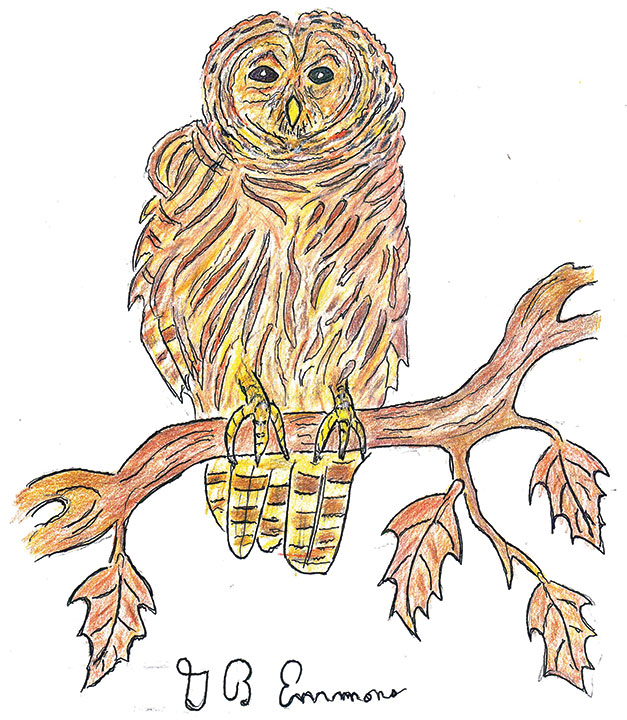Two new friendly neighbors who live nearby on Indian Road of Sconticut Neck in Fairhaven report seeing a barred owl perched during the day on a tree limb above their homes. As avid bird watchers and readers of my wildlife columns in The Wanderer, they both stopped me there on my usual afternoon walk to announce the exciting news of this mid-winter visitor.
The barred owl gets its name from the deeply colored bars on the feathers of its wings and tail. It is also known as the puffy headed hoot owl with a large sturdy body streaked and spotted with variated brown, buff, and white coloring, as in my illustration.
It is considered very vocal because in the dead of night it calls out a startling eight loud hoots! The first four sound like “Who cooks for you?” and the second four end with a southern sounding drawl “Who cooks for ya’ll?” It is only one of three owl species with black eyes. This color adaptation renders the barred owl’s sight effective only for seeing in the dark. The yellow eyes of the snowy owl are for diurnal vision of night and day, and the orange eyes of the great horned owl are for dim light of either dawn or dusk.
Its sudden presence here might be explained because the male of the species only migrates a short distance. It moves into urban habitats like Indian Road for winter, and then in spring back to the thick woodlands. Its diet includes small terrestrial mammals, birds, lizards, and snakes, but also fish, crayfish, and crabs of the shoreline aquatic habitat.
When barred owls begin to mate in late winter, they give forth a loud series of howling screams that are quite frightening. This scary performance is called “caterwauling.” It sounds like monkeys fighting in the treetops, as in the saying ”Two is company and three is a crowd.” Mating owls are said to perform aerial acrobatics while wildly soaring upward in a mating dance to this unearthly din. The owls subsequently mate and then nest in the cold of winter.
As as each egg is laid, they are forced to immediately begin incubating, resulting in a size variance that can be detrimental to survival of the last to hatch. Nests can easily be located and identified by finding a number of hairballs all around and beneath the nesting tree. These are indigestible pellets of bone and hair from their diet, regurgitated and spit out to the ground below.
Nesting owls have been known to dive bomb human intruders approaching a nest of their brood. Consequently, it is better to bird watch from a respectable distance. I will remember that in my future walks, possibly having the third largest owl in New England, after the snowy and great horned, watching my every move in passing down Indian Road.
Let me conclude my tale of this wise old owl with its anthropomorphic existence keeping us awake at night with its human-sounding conversation. I hope that I have painted a natural and mystical picture of lasting impression to enjoy with me, in environmental awareness, on one of my afternoon walks.
By George B. Emmons
